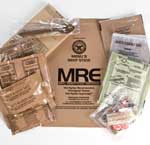Overview
 The MRE (meal, ready to eat) is one of the most ingenious and versatile food items the world has ever seen. Their origins are in the Revolutionary War when Congress passed a resolution to make rations that could feed a man for one day. This mainly consisted of beef, peas, and rice. Over the years, the rations evolved into mountain rations, jungle rations, C rations, and the MCI field ration.
The MRE (meal, ready to eat) is one of the most ingenious and versatile food items the world has ever seen. Their origins are in the Revolutionary War when Congress passed a resolution to make rations that could feed a man for one day. This mainly consisted of beef, peas, and rice. Over the years, the rations evolved into mountain rations, jungle rations, C rations, and the MCI field ration.
meal ready to eatIn 1963, the Department of Defense began creating the foundation for the modern MRE. It became standard issue in 1986 with 12 entree options. After the Gulf War, Colin Powell was instrumental in pushing for increased quality and variety in the MRE. Starting in 1998, service members could choose from up to 24 entrees and more than 150 additional items.
Specs
Each MRE provides about 1,200 Calories. They are intended to be eaten for a maximum of 21 days (the assumption is that logistics units can provide superior rations by then), and have a shelf life of three years (depending on storage conditions). Each MRE weighs between 18 and 26 ounces. The MRE’s are also built to withstand a drop from 1,250 feet since many of them are parachuted into combat areas.
Summary
Although MRE’s are no doubt endearing to the thousands of military men and women who have had to use them over the years, we don’t feel like MRE’s are an optimal choice for home food storage. They don’t have a long shelf life, and their taste is not on the level of current freeze-dried entrees. However, if you would like to explore purchasing MRE’s we recommend the following outlets:





